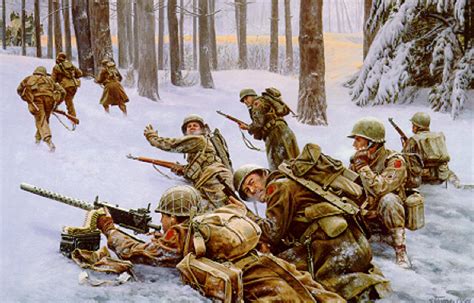
The 99th Infantry Division, often overlooked in historical accounts, played a pivotal role in blunting the German offensive during the Battle of the Bulge, buying crucial time for reinforcements and ultimately contributing to the Allied victory. Despite being a relatively inexperienced unit holding a quiet sector of the front, their tenacious defense against overwhelming odds significantly disrupted the German timetable and prevented a critical breakthrough.
The Ardennes Forest in December 1944 was anything but quiet for the men of the 99th Infantry Division. Deployed in a supposedly “quiet” sector along the Elsenborn Ridge, the division found itself directly in the path of the German army’s desperate last-ditch offensive, later known as the Battle of the Bulge. What followed was a harrowing fight for survival that not only tested the division’s mettle but also proved to be a critical factor in the overall Allied victory.
The 99th Infantry Division, nicknamed the “Checkerboard Division” for its distinctive shoulder patch, had arrived in Europe only weeks before the German offensive. Many of its soldiers were fresh replacements, lacking extensive combat experience. They were tasked with holding a thinly stretched 26-mile front, a sector deemed low-priority by Allied command. This perception of calm, however, was shattered on December 16th, 1944, when the German army launched its massive surprise attack.
The German plan aimed to break through the Allied lines, seize Antwerp, and split the Allied forces, effectively crippling their war effort. The 99th Infantry Division, along with elements of the 2nd Infantry Division, stood directly in the path of the northernmost German advance, spearheaded by the powerful Sixth Panzer Army. Facing them were battle-hardened German infantry and Panzer divisions, vastly superior in numbers and firepower.
The initial German assault was overwhelming. “The Germans were throwing everything they had at us,” recalled one veteran of the 99th. Despite being heavily outnumbered, the inexperienced American soldiers fought with extraordinary courage and determination. They utilized the terrain to their advantage, setting up ambushes and using their limited artillery support to inflict heavy casualties on the advancing Germans. The battle quickly devolved into a series of desperate, close-quarters engagements. Soldiers fought from foxholes, houses, and even tree lines, often relying on individual acts of heroism to hold their ground.
One critical aspect of the 99th’s defense was their ability to delay the German advance. They managed to slow down the enemy’s timetable, preventing them from reaching key objectives and allowing the Allies to reorganize their defenses. This delay proved crucial in allowing General Eisenhower to reinforce the Ardennes with battle-hardened divisions, including the 82nd Airborne and 101st Airborne. The 82nd Airborne, for example, was rushed to Werbomont to block the advance of Kampfgruppe Peiper, a key element of the German Sixth Panzer Army. The 101st Airborne famously held Bastogne, further disrupting the German offensive.
The fighting along the Elsenborn Ridge was particularly fierce. The 99th Infantry Division, along with elements of the 2nd Infantry Division, held their ground despite repeated German assaults. They utilized their artillery effectively, inflicting heavy casualties on the enemy and disrupting their formations. The bitter cold and snow added to the misery of the fighting. Soldiers suffered from frostbite, trench foot, and exhaustion, yet they continued to fight with unwavering determination.
The stand of the 99th Infantry Division was not without cost. The division suffered heavy casualties, with hundreds of soldiers killed, wounded, or missing. Despite these losses, they managed to hold their ground and prevent the Germans from achieving a critical breakthrough. Their actions bought valuable time for the Allies to reinforce the Ardennes and ultimately turn the tide of the battle.
While the battles of Bastogne and St. Vith have received significant attention in popular accounts of the Battle of the Bulge, the contributions of the 99th Infantry Division have often been overlooked. Historians and veterans argue that their tenacious defense was just as important, if not more so, in preventing a German victory. The 99th’s stand disrupted the German timetable, prevented a critical breakthrough, and allowed the Allies to reinforce their lines. “They were the hinge on which the battle swung,” stated one historian specializing in the Battle of the Bulge.
The Battle of the Bulge raged for several weeks, with fierce fighting continuing throughout the Ardennes Forest. The Allies eventually pushed back the German offensive, but the battle remains one of the bloodiest in American military history. The 99th Infantry Division continued to fight throughout the campaign, playing a key role in driving the Germans back to the Siegfried Line.
The sacrifices made by the men of the 99th Infantry Division deserve to be remembered. Their courage, determination, and unwavering commitment to duty were instrumental in preventing a German victory in the Battle of the Bulge. They are truly forgotten heroes who played a vital role in the Allied triumph in World War II. Their story serves as a reminder of the importance of every soldier, regardless of their experience, in the face of adversity. The battle also underscores the critical role of even “quiet” sectors in the broader strategic landscape of warfare. A perceived lull can quickly turn into a critical front line, demanding vigilance and unwavering resolve from those tasked with its defense. The 99th Infantry Division exemplified that resolve, holding the line against overwhelming odds and ensuring the eventual Allied victory.
The relatively inexperienced soldiers of the 99th, thrown into the thick of a desperate German offensive, exhibited remarkable resilience and tactical acumen. They made the most of the terrain, utilizing natural defenses and skillfully employing their limited resources to inflict maximum damage on the advancing enemy. This resourcefulness, combined with sheer determination, allowed them to punch above their weight and significantly impede the German advance.
Moreover, the 99th’s defense highlighted the crucial importance of even seemingly insignificant units in the overall strategic picture. Allied commanders initially viewed their sector as low-priority, but the German offensive quickly transformed it into a vital front line. The 99th’s performance underscored the need for constant vigilance and preparedness, even in areas perceived to be relatively quiet.
The Battle of the Bulge remains a testament to the courage and sacrifice of American soldiers in the face of overwhelming odds. While the stories of Bastogne and other key battles often dominate the narrative, the stand of the 99th Infantry Division deserves recognition as a pivotal moment in the campaign. Their actions not only contributed to the Allied victory but also exemplified the resilience and determination of the American soldier in the crucible of war.
The legacy of the 99th Infantry Division extends beyond their contribution to the Battle of the Bulge. Their performance serves as an inspiration to soldiers and leaders alike, demonstrating the importance of courage, determination, and adaptability in the face of adversity. Their story is a reminder that even seemingly ordinary individuals can achieve extraordinary things when faced with extraordinary circumstances. It is a story that deserves to be told and retold, ensuring that the sacrifices of these forgotten heroes are never forgotten.
The fight of the 99th underscores the unpredictable nature of war and the importance of adaptability. The division’s initial deployment to a “quiet” sector lulled many into a false sense of security, highlighting the dangers of complacency in military planning. The swift and brutal German offensive shattered this illusion, forcing the 99th to quickly adapt to a desperate situation. Their ability to do so, leveraging their limited resources and exploiting the terrain, proved crucial in slowing the enemy’s advance.
Furthermore, the 99th’s experience highlights the psychological toll of combat, particularly on inexperienced soldiers facing overwhelming odds. The constant threat of attack, the bitter cold, and the heavy casualties undoubtedly took a significant toll on the men of the division. Yet, they persevered, displaying a remarkable level of resilience and commitment to their duty. Their story is a testament to the human spirit’s ability to endure even the most extreme conditions.
In conclusion, the story of the 99th Infantry Division during the Battle of the Bulge is a compelling example of courage, determination, and the importance of adaptability in the face of adversity. Their often-overlooked contribution to the Allied victory deserves to be remembered and celebrated. They stand as a testament to the resilience of the American soldier and the critical role of every individual in the overall success of a military campaign. Their actions disrupted the German timetable, prevented a critical breakthrough, and allowed the Allies to reinforce their lines, ultimately contributing to the Allied victory. Their legacy as forgotten heroes should inspire future generations to appreciate the sacrifices made by those who served in World War II. The story of the 99th Infantry Division is a reminder of the importance of recognizing and honoring the contributions of all soldiers, regardless of their unit or the prominence of their battles. Their courage and sacrifice deserve to be remembered and celebrated as an integral part of the Allied victory in World War II.
The impact of the 99th Infantry Division’s actions resonated far beyond the immediate battlefield. By holding the line against a superior enemy force, they not only bought time for Allied reinforcements but also significantly impacted the morale of both sides. The German offensive, intended to be a swift and decisive blow, was bogged down in the Ardennes, gradually sapping their resources and momentum. Conversely, the 99th’s tenacious defense bolstered the confidence of Allied forces, demonstrating the resilience and fighting spirit of the American soldier.
The Battle of the Bulge, in its entirety, served as a harsh lesson in the importance of intelligence gathering and accurate assessment of enemy capabilities. The Allied high command’s underestimation of the German army’s ability to launch such a large-scale offensive nearly resulted in a catastrophic defeat. The 99th Infantry Division, caught in the path of this unexpected assault, bore the brunt of this intelligence failure. Their experience underscores the need for constant vigilance and accurate intelligence to prevent similar surprises in future conflicts.
Beyond the strategic and tactical implications, the story of the 99th Infantry Division is also a deeply personal one. Each soldier who fought in the Ardennes faced unimaginable hardships and witnessed scenes of unimaginable horror. The bonds forged in combat, the camaraderie and shared experiences, created a lasting connection among the men of the division. Their story is a reminder of the human cost of war and the sacrifices made by ordinary individuals in extraordinary circumstances.
The legacy of the 99th Infantry Division serves as a valuable case study for military historians and strategists. Their experience highlights the importance of factors such as terrain, leadership, and the adaptability of troops in determining the outcome of battles. Their successful defense, despite being outnumbered and outgunned, demonstrates the potential for even relatively inexperienced units to achieve significant results with proper training, effective leadership, and a strong will to fight.
The story of the 99th Infantry Division during the Battle of the Bulge is a testament to the human spirit’s ability to endure and overcome adversity. Their courage, determination, and sacrifice deserve to be remembered and celebrated as an integral part of the Allied victory in World War II. The story of the 99th Infantry Division is a reminder of the importance of recognizing and honoring the contributions of all soldiers, regardless of their unit or the prominence of their battles.
The actions of the 99th Infantry Division also highlight the importance of logistics in modern warfare. The division’s ability to effectively utilize its limited resources, including artillery and supplies, was crucial in slowing the German advance. Their experience underscores the need for a robust and efficient logistical network to support troops on the front lines. Without adequate supplies and ammunition, even the most courageous soldiers are unable to sustain a prolonged defense.
The Battle of the Bulge remains a significant event in American military history, not only for its scale and intensity but also for the lessons it provides about leadership, strategy, and the human cost of war. The story of the 99th Infantry Division is an important part of this narrative, offering valuable insights into the challenges and sacrifices faced by American soldiers in the European theater of World War II.
The story of the 99th Infantry Division is a compelling reminder of the importance of historical accuracy and the need to recognize the contributions of all those who served in the war. Too often, the focus is placed on the most well-known battles and the most celebrated units, while the sacrifices of others are overlooked. The story of the 99th Infantry Division is a reminder that every soldier played a role in the Allied victory and that their contributions deserve to be remembered.
The courage and sacrifice of the 99th Infantry Division during the Battle of the Bulge should serve as an inspiration to future generations of soldiers and citizens alike. Their story is a reminder of the importance of defending freedom and democracy and the willingness to make sacrifices for the greater good.
The story of the 99th is not just a military history lesson; it’s a human story of resilience, brotherhood, and the enduring power of the human spirit in the face of unimaginable hardship. It’s a story that continues to resonate today, reminding us of the importance of remembering and honoring those who served and sacrificed for our freedom.
Frequently Asked Questions (FAQs)
-
What was the Battle of the Bulge, and why was it significant?
The Battle of the Bulge was a major German offensive campaign launched in the Ardennes region of Belgium, France, and Luxembourg in December 1944. It was Hitler’s last major offensive on the Western Front during World War II. The battle was significant because it was a desperate attempt by the Germans to break through Allied lines, recapture Antwerp, and split the Allied forces. Had they succeeded, it could have significantly prolonged the war. The battle is considered one of the bloodiest battles for the U.S. Army in World War II.
-
What role did the 99th Infantry Division play in the Battle of the Bulge?
The 99th Infantry Division was tasked with holding a supposedly “quiet” sector along the Elsenborn Ridge. However, they found themselves directly in the path of the German offensive. Despite being relatively inexperienced and outnumbered, they put up a fierce and tenacious defense, slowing down the German advance and preventing a critical breakthrough. This bought crucial time for the Allies to reinforce their lines and ultimately turn the tide of the battle. The division’s actions have often been overlooked in historical accounts, but many argue that their defense was crucial to the Allied victory.
-
Why is the 99th Infantry Division considered a “forgotten” or “overlooked” unit?
While battles like Bastogne received much attention, the 99th Infantry Division’s contribution was often overshadowed. This could be due to a number of factors, including the division’s relative inexperience, the fact that they were initially assigned to a “quiet” sector, and the focus on more dramatic events elsewhere during the battle. However, historians and veterans argue that their tenacious defense was just as important, if not more so, in preventing a German victory.
-
Where exactly did the 99th Infantry Division fight during the Battle of the Bulge?
The 99th Infantry Division primarily fought along the Elsenborn Ridge in Belgium. This strategic high ground was critical to controlling access to key roads and preventing the German advance into the northern sector of the Ardennes. Their defense of the Elsenborn Ridge, alongside elements of the 2nd Infantry Division, was crucial in preventing the Germans from achieving their objectives in that area.
-
What were the casualties suffered by the 99th Infantry Division during the Battle of the Bulge?
The 99th Infantry Division suffered heavy casualties during the Battle of the Bulge, with hundreds of soldiers killed, wounded, or missing. Exact figures vary, but it is generally accepted that the division experienced significant losses due to the intensity of the fighting and the overwhelming odds they faced. Despite these losses, they managed to hold their ground and prevent the Germans from achieving a critical breakthrough.









